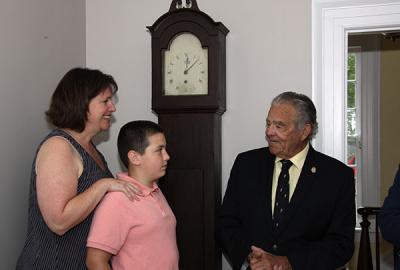Gifts for the Dominy Workshops’ Return

As East Hampton Village prepares to return the historic Dominy clock and woodworking shops to their original location on North Main Street, donations of 18th and 19th-century artifacts, including a book owned by Mayor Paul F. Rickenbach Jr. and his wife, Jean, were presented to the East Hampton Village Board on Friday.
Robert Hefner, the village’s director of historic services, explained the plan for the shops, which were part of a Dominy family compound. The family, including Nathaniel Dominy IV, his son Nathaniel Dominy V, and his grandson Felix, were renowned for their woodworking and clock and watchmaking skills. So renowned, in fact, that an exact replica of their shops was created at the Winterthur Museum in Delaware.
The 1791 woodworking shop and 1798 clock shop are the only Dominy buildings still in existence; the family’s house and other structures were torn down in 1946. The village anticipates that the shops, which are being held for safekeeping at Mulford Farm, will be relocated during the 2019-20 fiscal year. Mr. Hefner explained that a timber-frame house in keeping with the architecture of the time would be constructed at the site as an exhibition area.
The donation from the mayor and his wife — a purse with a leather-bound memorandum book sewn inside — will be one of the items on exhibit. The first page of the book, which contains hand-written business records and personal information, reads: “Nathaniel Dominy, his book, 1787 East Hampton.” On a subsequent page, Mr. Dominy noted that he earned 125 pounds in 1795, 53 pounds of which was in payment for building the windmill on Gardiner’s Island. He also “wrote down the births, marriages, and deaths of his family,” Mr. Hefner said, “and a couple of succeeding generations used the book for the same purpose.”
The book was passed down to Daniel Kellogg, whose great-great-grandfather was Nathaniel Dominy VII. Mr. Hefner said Mr. Kellogg had not decided on a permanent place for his “family treasure” until he learned of the plans for the village’s Dominy compound. “He agreed to part with it. The mayor and his wife purchased it, and we’re very, very thankful for this donation,” he said.
Mr. Hefner then invited Ms. Rickenbach to the podium. Being able to provide the book to the village was “extraordinary,” she said, “to actually hold this in your hand and know that this is going to be safe forever.”
Richard Barons, the former executive director of the East Hampton Historical Society, presented the next donations, which include a tall-case clock made by Felix Dominy, a slat-back chair, two candle stands, and a sailor’s duffel box made by Nathaniel V. They are a gift from Maureen McFall Cayer and her son David James Cayer in memory of Ms. Cayer’s stepmother, Kathleen Elizabeth Flannery McFall.
“This clock is one of the most perfectly preserved tall-case clocks from the Dominy family that we’ve ever seen,” Mr. Barons said. “When I examined it, I couldn’t even find one replaced nail.” The clock, the second that Felix Dominy made, has been painstakingly documented. His father built the case, it has retained its original paint, its pewter pendulum bears Felix’s monogram, and the clock’s 10-pound weight is inscribed with the date 1817. “It also gives the exact date of when the clock was made,” Mr. Barons said, noting that it was Aug. 8, 1818.
“I think we’re going to have a birthday party for it in a month or two because it will be having its 200th birthday.” The seaman’s chest, Mr. Barons said, has original red paint and contains a secret drawer.
Following the presentation, Ms. Cayer said that Ms. McFall, a direct descendant of the Hedges family, one of East Hampton’s founding families, would have been delighted with the donation. “She had such a love for this community.” she said.
The third donation of the day was a $9,000 check from the landmarks committee of the Ladies Village Improvement Society. The money is earmarked for the construction of the front door of the reconstructed Dominy house, Mr. Hefner said. “The Dominy house along with the Clinton Academy were the major Georgian-style structures in East Hampton,” he said, adding that the door was likely the widest residential doorway at the time.
Delivering the check, Mary Busch, chairwoman of the L.V.I.S.’s landmarks committee, thanked the public for supporting her organization’s mission. “We have made extensive efforts to recognize preservation and restoration in the community and that’s how we can make this gift possible,” she said.
In other business, the village authorized a lease agreement with East Hampton Town for an intermunicipal fire substation in Northwest Woods. The mayor also announced that Michael Bouker, the deputy superintendent of public works, will present a 2018 stormwater report at the village board’s organizational meeting on July 3.
The board also heard from Michael Zotos, an artist who would like to install some of his work on Main Street. “If you’re not going to call code enforcement on me, I’ll stick them in the ground, and leave them there for the season,” he said. The mayor, who praised Mr. Zotos’s creative talent and entrepreneurial spirit, nevertheless pointed out that there were certain protocols involved. He suggested that the artist meet with Becky Molinaro Hansen, the village administrator, and one or more of the village trustees to see if the work could be accommodated.
